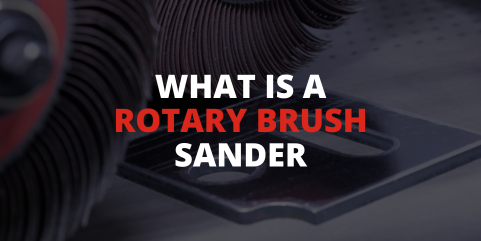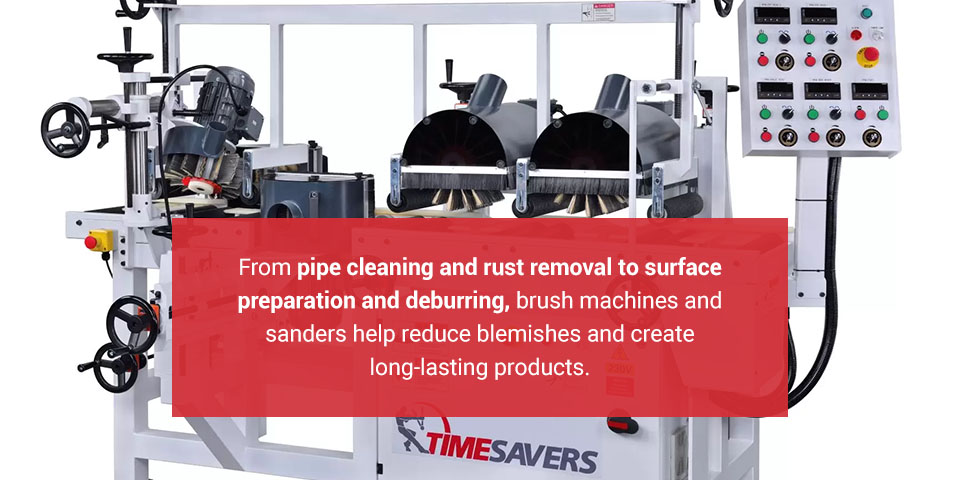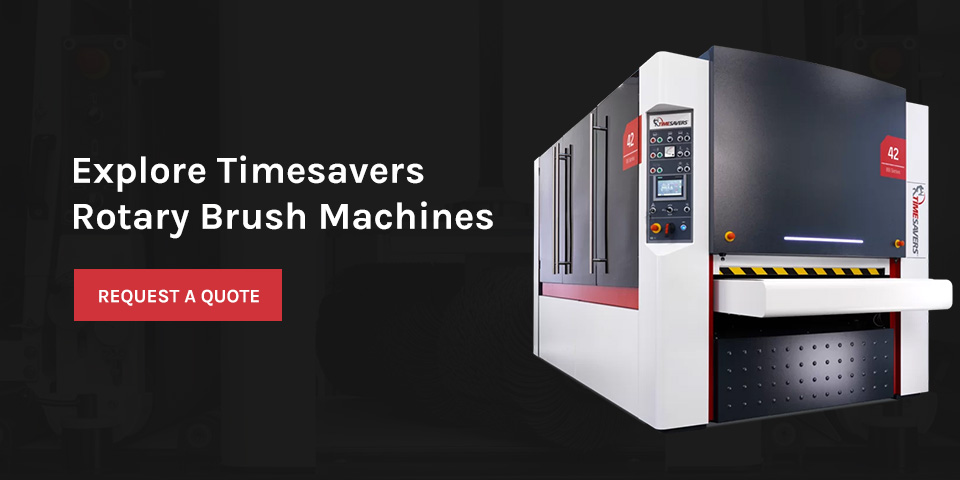What is a Rotary Brush Sander?

A rotary brush sander helps those in the manufacturing business clean and prepare materials and products for finishing. Understanding the various types of brushes, wires and applications can help you choose the suitable machine for your needs. Whether you need to clean pipes or deburr materials, a reliable rotary brush sander improves production speeds and your bottom line.
Rotary Brush Machine: Defined
A rotary brush machine or sander helps manufacturers prepare their products for finishing. Others use rotary brush sanders to clean metal and wood items of burrs and marks. During the sanding and brushing process, sanding and deburring brushes rotate around an axis to clean or perfect metals and wood. Rotary brush machines may be industrial or handheld tools.
Types of Rotary Wire Brushes
You can use different kinds of rotary wire brushes for various manufacturing applications. While many brushes exist, there are three popular rotary brushes to remember — cylinder, cup and wheel brushes.
1. Cylinder Brushes
Cylinder brushes have a broader face and are often used to clean or prepare a product for finishing. They can handle large substrate areas and contain a strip brush on a cylindrical-shaped core. Some have filament tufts contained in a core.
Depending on the length of your filaments and wires, the brush may operate more or less aggressively while cleaning a surface. For example, a shorter filament length on a cylinder brush may work more aggressively than a long filament.
2. Cup Brushes
Cup brushes are often used for surface preparation, descaling or polishing applications. The name of a cup brush comes from its unique design.
A cup-shaped base holds wire filaments, usually brass, steel or stainless steel. The bristles and filaments of a cup brush can come in crimped, twisted and knotted designs, though crimped and knotted bristles are among the most common.
Sometimes, cup brushes have unique designs to fit the needs of a specific production, manufacturing or finishing application.
3. Wheel Brushes
Manufacturers enjoy wheel brushes for their versatility, as they also provide precise, effective cleaning for surface finishing, polishing, paint removal, cleaning or deburring. Wheel brushes may be used as individual machines or mounted together and used in groups.
Crimped vs. Knotted Wire and Brushes
Crimped and knotted wire are among manufacturers’ most popular brush types. From their versatile abilities to their long-lasting strength and operation, crimped and knotted wires offer different benefits depending on your company’s needs.
Crimped Wire
The filaments of crimped wire and brushes are shaped in wavy, pinched or twisted tendrils. They’re often made of steel, brass or chrome steel. The crimped shape helps separate the filaments from each other to reduce wire rigidity. Crimped wire also helps reduce the chance of broken wires from heavy-duty applications like flexing, traveling and turning machines.
In some cases, oil-tempered wire versions of crimped brushes may cost more but last longer than other designs. The crimped wire may only be appropriate for light-duty applications and operations due to its tendency to break apart after a while. Small wire pieces may fall off the brush, leaving some cutting edges uncovered.
However, crimped wire often makes breakage clean and sharp. So, while wires falling out of the brush are common, the crimping design removes and smooths imperfections caused by fallen wires and breakage.
Knotted Wire
Knotted wire brushes are designed with tiers or loops of steel or chrome steel. Many manufacturers appreciate that knotted wire brushes assist with hacking, twisting and other methods that may result in weakened metal.
This kind of brush often promotes aggressive brushing actions for heavy-duty applications. As the loops twist over the length of the product, the manufacturer can exchange different wire sizes and applications for performing heavy brushing actions.
Knotted wires are sometimes made with cable twist designs, often used in oil pipelines and fields. Whichever size or structure of knotted wire your company needs, the brushes can help with surface painting for narrow grooves and divots or pre-welding work in pipe applications.

Common Uses for Rotary Brush Machines
Rotary cleaning brushes used for industrial wire brush machines are commonly found in manufacturing. From pipe cleaning and rust removal to surface preparation and deburring, brush machines and sanders help reduce blemishes and create long-lasting products.
Here are five common uses for rotary brush machines:
1. Pipe Cleaning
Rotary brush machines can clean pipes because they can reach between surfaces. While typical pipe cleaners may be shaped in sizes equal to or larger than the pipe’s diameter, a brush machine and sander can push, clean and destroy obstructions on and inside pipes using their unique abilities. Rotary brushes may bend with the pipe’s curve or conform to its shape while also preparing the surface of the pipe for finishing coats or other applications.
2. Rust Removal
Rotary brushes can help remove rust from small spaces on materials by digging into cracks and tight areas. A heavy-duty rotary brush machine can do the trick for those who want to clean off flakes of rust or paint from large, encrusted spaces and surfaces.
3. Surface Preparation
In some cases, manufacturers may want to prepare a surface for a coat of finishing product or surface protection. A bit of roughness in surface applications is necessary to ensure the finishing material sticks to the final product. Manufacturing plants and factories use brushes and sanders to ensure a successful product.
4. Wood Distressing
Another everyday use for rotary brush sanders is wood distressing. Companies that manufacture various wood products must produce a good finish by improving the product’s appearance before use. Brush sanding machines help eliminate imperfections on wood products and distress the wood itself before sending it off for finishing touches.
5. Deburring
Deburring removes sharp edges and imperfections, often called burrs, from metal products. Brushes with various metal and wire filaments can help scrape off the burrs at a relatively low price and fast application. The consistency and intensity of deburring techniques may depend on the density, filament, velocity, texture and material type of the product you want to perfect.
However you plan to deburr your metal products, rotary sand brushes can give the material a smooth, clear edge without any micro burrs you can sometimes find on treated surfaces.

Explore Timesavers Rotary Brush Machines
Since 1946, Timesavers has assisted customers as reliable industrial brush manufacturers. We can meet your needs, wants and challenges with excellent equipment performance and personalized customer service and assistance.
From woodworkers and metalworkers to those in various other manufacturing industries, our products can help your company improve its productivity and efficiency. Check out our rotary brush machines or receive a quote from Timesavers today.
